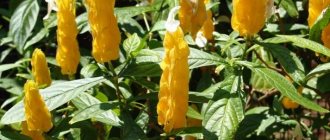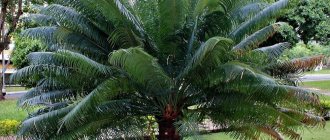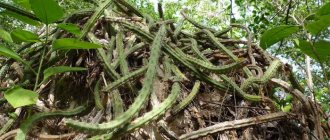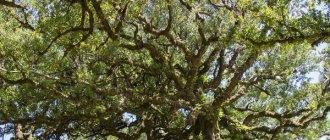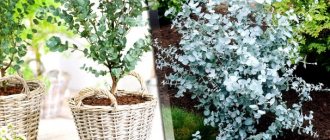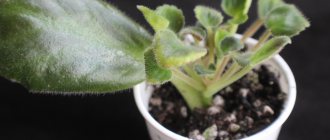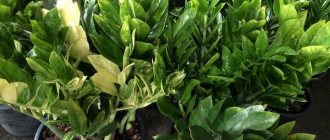Motherland
Plants with the unusual name “False palm” can be found in the tropics of various continents. They grow almost everywhere - in South and Central America, Madagascar, Australia, Southeast Asia.
In nature, these are huge plants with spreading leaves and small specimens from 35 centimeters. They are not very demanding; they have adapted to live in the shadow of other fauna.
If she grew up in an open space, she is not afraid of higher temperatures.
The indigenous population respects these plants. For them, the False Palm is the tree of life.
The roots have long been used instead of soap, and ropes are woven from the fibers of the leaves. Local healers make many medicines from plants of this species - ointments, decoctions. Shamans use extracts of some plants to perform rituals.
Description of the plant
The appearance changes as the plant matures.
The young “False Palm” has a stem densely covered with foliage. With age, the lower leaves die off and are located only at the top of the plant.
Smooth trunk and apical leaves create a characteristic palm effect.
Not all species grow up to become solitary plants. There are also shrubby forms among them.
The leaves are softer, unlike real palms. The color scheme is amazing. In some species the leaves are smooth along the edges, while in others they have spiny spines .
The root system is also different. If Cordyline has a creeping root, white with nodules , then in a plant like Pandanus the root consists of two parts . A young plant has all its roots in the ground. As they mature, aerial roots begin to grow from the bases of the leaves .
They not only decorate the plant, but also provide some support. A grown plant has a very large mass of leaves, which is difficult for a not very thick trunk to hold in an upright position. And aerial roots serve as an additional basis for the plant.
The stem also differs between species. Smooth and straight in Yucca and Cordyline, it curls into a spiral in Pandanus .
Large specimens are grown to decorate public spaces. Smaller ones are firmly established among flower growers around the world.
You can clearly see the types of plants in the photo below:
Cordilina
Yucca
Pandanus
Possible methods of reproduction
The flower is sown with seeds in February or March. Domestic palm trees are not easy to propagate. But if you follow all the tips, you can succeed:
- Seeds are bought in a specialized store. Fresh plants will germinate in 20-30 days. Otherwise, germination time will take 2-4 months.
- Small seeds are poured with warm water and left for 3-4 days. Large ones need to be trimmed.
- For planting, use small pots with holes to drain excess moisture. Drainage is placed at the bottom, covered with fertile soil.
- The seeds are buried 2-3 cm into the soil at intervals of 3 cm. Containers with soil are moistened and covered with foil.
- When the seedlings reach a height of 10 cm, they are transplanted again.
Germination must be carried out at a temperature of 20-22 C (for subtropical species) or 28-30 C (for tropical species).
Shrub palm species (such as rapeseed and caryota) can be propagated by root methods. The flower is carefully removed from the ground, and a shoot with full roots is separated from it with a sharp knife. The cut site is treated with activated carbon. The sprout is planted in a separate pot at the same depth as originally.
Seed method
Suitable for all types of palms, but howea, livistona, likuala, trachicarpus and washingtonia reproduce only by seeds. This method requires time and effort. Here's what the step-by-step process looks like:
- Choose large, whole and fresh seeds. The longer they are stored, the lower their ability to germinate.
- The seed material is soaked for 5 days.
- Disposable cups are filled with a mixture of vermiculite soil, leaf soil and perlite in equal proportions. A small hole is made in the lower part. You can land in a large container.
- The seed is immersed 2 cm into the soil. The soil is moistened with a sprinkler.
- The crops are covered with film to create a greenhouse effect.
- The cups are placed in a warm place, regularly ventilating and watering the soil.
- When shoots appear, the containers are moved to a bright place.
- After rooting and the appearance of full-fledged leaves, the plants are transplanted into permanent pots.
Seeds germinate slowly, the process sometimes drags on for several months.
Root shoots
Suitable for palm trees growing as a bush: Hamerops, Chrysalidocarpus, Roblena, Carita, Date, Hamedorea. This method is used during the growing season, when plants are actively growing and developing. Choose a root sprout near the mother bush. It is separated with a sharp knife. The cut is sprinkled with crushed activated carbon to disinfect the wound.
Detailed article about the date tree.
The seedling is placed in a pot prepared with soil, placed in a warm place and covered with foil for rooting. At this time, the shoot is regularly watered abundantly and periodically sprayed. A young palm tree can be moved to a permanent place in a ventilated area only after successful rooting and the appearance of the first leaves.
Tops
Propagated by yucca and dracaena. As a soil substrate, mix two parts garden soil and one part humus and sand. Cut off the top, free the trunk from the leaves and place it in the soil mixture prepared for rooting.
The survival rate is very high - up to 90%. Cover the container with foil or glass and place it in a warm, bright place. When the first leaves appear, remove the lid and place the pot in a permanent place. In addition, they are looked after like an adult palm.
Home care
Caring for these plants at home is not difficult. Like all tropical plants, they are very demanding of good lighting. They do not like bright, direct sunlight.
They may get leaf burn from the sun.
The temperature in winter is not lower than 12 degrees . Water abundantly from spring to autumn, and in winter, water rarely and only with warm water. Due to the fact that false palms grow very slowly, replant them as necessary .
Photo gallery
A large assortment of varieties and species diversity will help anyone choose a plant to suit their taste and character.
The most common types
- Cordyline is perhaps in a special place in terms of the beauty of its leaves.
Recently, breeders have offered a huge number of these plants. With wide and narrow leaves, with colors from dark burgundy to rainbow , with a huge variety of colors. There are many forms of this false palm in cultivation. - Yucca is another false palm. An adult Yucca is an expensive plant that requires appropriate treatment.
Yuccas come in two types: without trunk - perennial evergreen shrub and with barrel - tree.Types of Yucca with a trunk: Elephantis (Elephantis), Gray. Yucca shrub: Filamentosa (Filamentous), Aloe-leaved.
Gardeners love Yucca for its flowering. If you grow Yucca at home, you will have to wait for flowering for many years. And even then it’s not a fact that it will bloom.
- Another representative of this species is Pandanus. In nature, this is a huge plant, the height of a three-story house.
From afar, Pandanus looks like a fairy-tale giant with a huge stem - a body, twisted in a spiral and many roots - legs, intricately curved.The leaves, narrow with thorns along the edges, are arranged in a spiral on the stem . In a young plant this is not very noticeable.
Watch a useful video about Pandanus below:
Diseases and pests
Pests and diseases are extremely rare on this hardy plant. But, I repeat, improper care can become the catalyst that provokes both fungal diseases and the appearance of pests.
Table: diseases and pests of pandanus, control measures and prevention
| Diseases and pests | Symptoms and manifestation | Control measures | Prevention |
| Leaf spot | A fungal infection affects the leaves. Spots of different colors appear on them, having a round or oval shape. With high humidity, the leaves wilt. |
Spray with one of the fungicides - Topaz, Fundazol. Please read the instructions carefully before use.
3 or 4 times. |
loose, well permeable to water.
keep under control to prevent increases.
waiting until the top layer of soil dries. |
| Root and stem rot | The most common disease caused by excessive watering and cold air. The leaves initially become yellow and limp. Then they get dark. Rotten areas appear on the roots and trunk. The plant may quickly wither. |
pot.
damaged areas of roots.
Cuprosan or Chometsin for 15 minutes to kill fungi.
coal.
with disinfected soil mixture.
fungicide. If the disease has damaged the trunk, then you need to cut off and root the top. | |
| Shchitovka | The leaves become covered with brown tubercles and sticky secretions. Pests hiding under the shield actively suck the juice from the leaves. As a result, the leaf dries out and curls. |
the following drugs are used: Karbofos, Actellik, Fufanon. Instructions included.
treatment is carried out 2 - 3 times at intervals of a week. Medicines can be changed. Treat in the fresh air or with an open window, as the drugs are toxic. |
To get rid of a recently manifested pest, wipe the leaves with a napkin soaked in a solution of laundry soap (20 g of soap shavings per 1 liter of water). Wiping should be done every week, paying special attention to the scale insects.
tincture of onion or garlic.
allow it to increase or decrease.
in which pandanus grows. |
| Mealybug | Has a cotton-like coating appeared in the leaf axils? This indicates a mealybug infestation. The leaves turn yellow, fall off, and growth stops. The plant is weakening. | ||
| Spider mite | The most common pest that appears if the air is very dry. Its presence is indicated by a thin cobweb. The pest sucks juices from the leaves through small punctures, which appear as small dots. The leaves curl, dry out and fall off. |
Photo gallery: diseases and pests
Leaf spotting appears when watering rules are not followed and humidity increases.
Putrefactive processes in the stem and roots can lead to the loss of the plant
The scale insect is very insidious, you need to be vigilant when fighting it
Mealybug weakens the plant
Spider mites cause leaves to dry out
